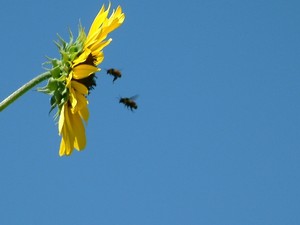18 Mar Wed 2009
Don't Fence Me In!
Is the grass greener on the other side?
We’re constructing a fence to keep our birds from grazing on our neighbor’s field. They just discovered the tasty grasses and things there! They’re not bad birds, but they do need some structure in their lives. Several hundred feet of structure.
They are, thankfully, not complaining. They seem to remember that the fields they used to enjoy aren’t so bad. Here’s a picture of the fence going in by our driveway. See our truck? Look nearby and you’ll see Scuttle the rooster helping to corral one of the more determined hens.
The wood is coming from the trees we are thinning, and would have otherwise been composted. We are preventing fire risk by ensuring adequate fire block on either side, and not stacking the wood high. The wild animals will be able to get through, over and around. It presents a visual reminder for our domesticated animals where our property line is. They are very familiar with territory, and like to stay within our territory: our protection and food is best!
Sleepytime Sounds
We’re trying something new here. One of our favorite times is when all the birds go home and say goodnight to each other and to us. When we go to their coops to close the door for the night, the chickens sing to us a goodnight song. We have tried to record it so we could present it here in the blog. We’ll be experimenting with recording sound as well as images.
Goodnight!
Saving the Sierras by Killing One Tree at a Time - now with an address!
Saws and axes are still good enough for thinning trees. Shovels are still good enough for planting trees. And, it turns out, tents are still good enough for living in!
We love trees. Who doesn’t? Yet we cut down a big one - almost 4 feet across. Then we cut down another! And then we cut down many smaller ones in our farm’s Sierra forest.
Why?
The monoculture on our farm is unnatural. Just a few hundred years ago, the pines - which provided better lumber - were cut down to help build Fresno, Clovis, and even far away cities. John Muir and other primary sources describe, besides the lumbering of the forest, cutting the trees to make way for sheep and other domesticated livestock.
The oaks were better able to survive this crisis. Even after the big oaks were cut down for wood, their acorns sprouted up. Now, the forest is mostly oak - several kinds of oak.
The larger herbivores that would have checked the growth of these oaks were destroyed by over hunting - they competed with the livestock. So the trees today grow too close together, and the lack of diversity further encourages disease. All trees increase the amount of water in an ecosystem, but the large sequoias and redwoods excelled at it. Now the forests burn so easy.
We are thinning the trees to a healthy density, and then a bit more so we can make room for sequoias, redwoods, pinions, junipers, and other evergreens. We will also be planting apples, cherries, pears, raspberries, blackberries and other native fruits.
A healthy forest is a diverse forest, but ours will still lack those necessary large herbivores! They will come when the habitat is restored. The carnovores and the necrovores will also return.
We see it whenever we reclaim land for our crops. An increase in biodiversity will lead to more diversity. And this healthy forest will improve the yields in our vegetable and fruit patches.
In other news,
If you’d like to come see our progress - or help in the lumberjacking or tree planting - you can more easily find us now. After long days of trying to talk to a human being (alas, time not spent blogging or doing real farm work!), the County has finally (kindly) given to us an address! There was some problem that we could not get an address without a house, but after a long discussion with the County, they have decided to recognize our tents as residences. Now we can vote, too!
We’ll be blogging more about this later, but were so happy that we had to share it today.



